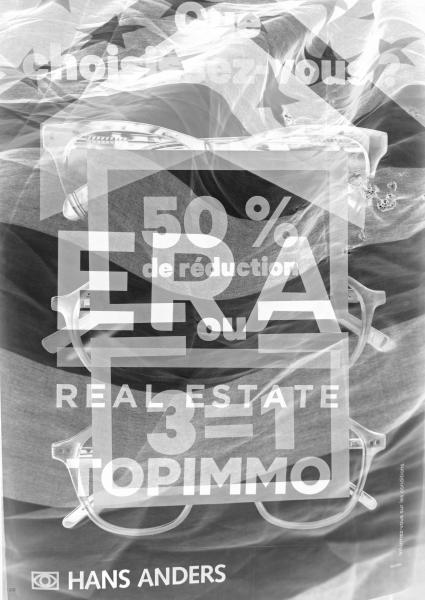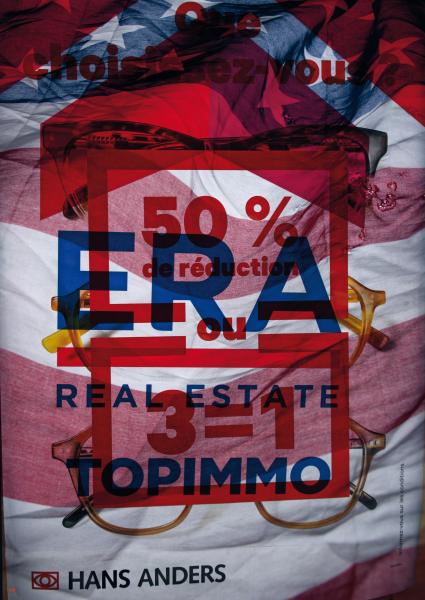A group of Persons
Proche des étoiles (et des commerces)
L'Orangerie, Bastogne
13.04-19.05.2024
Curators Gauthier Pierson, Sarah Godelaine
Project realised in collaboration with Fatma Abidi, Roland Bastenier, Charline Bihain, François Evrard, Amélie Hordebise, Philippe Houzé, Rafael Marques, Léopold Strepenne, et Carine Wynants
In 2023, an exhibition entitled “Close to the shops (and the stars)” was held at the Orangerie in Bastogne. It consisted of a colorful fresco on the floor, created by children over the course of four days.
A year later, I'm in the thrall of Georg Wilhelm Friedrich Hegel. I see everything in terms of antithesis. The new exhibition is therefore entitled “Close to the Stars (and to Business)”. It unfolds on the ceiling rather than on the floor. It is created over four nights, with adults, rather than during the day with children. Where the previous exhibition was in color, this one is in black and white. And from the plan, we slide towards volume. The result is a portrait of Bastogne by night rather than day.
At night, all cats are black. Everything is the same, yet slightly different. The minutes tick by, and we're somewhere between late awakening, dream, nightmare, hallucination, dream. The church is no longer necessarily in the middle of the village. The hand tries to grasp, blindly. But the project of perfect antithesis proves impossible. For reality intervenes. It puts its own spin on things. But then, where are we? Are we treading water in the thesis? Is the eternal thesis our only destiny? Or is the antithesis precisely this seasoned thesis? Or is it already the synthesis? And what does the middle class want in all this? Friedrich, may you enlighten us.
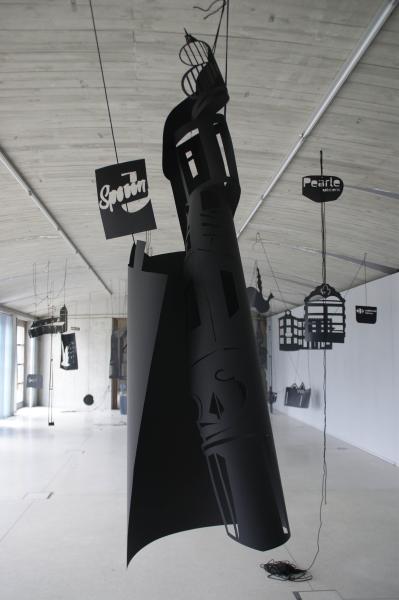
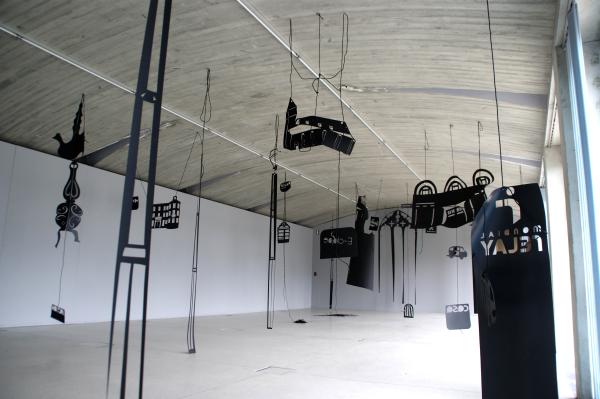
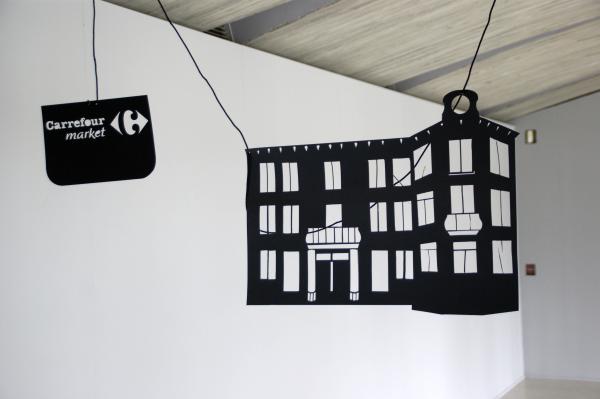
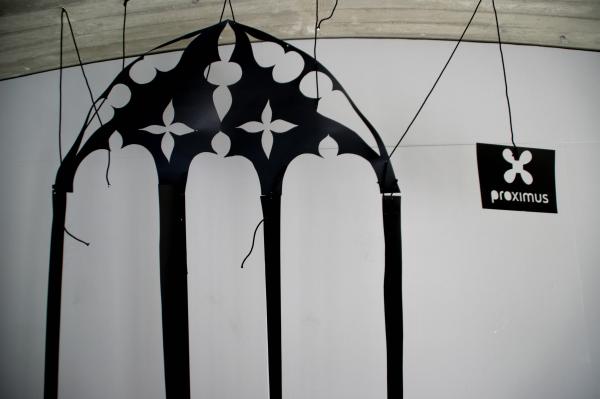
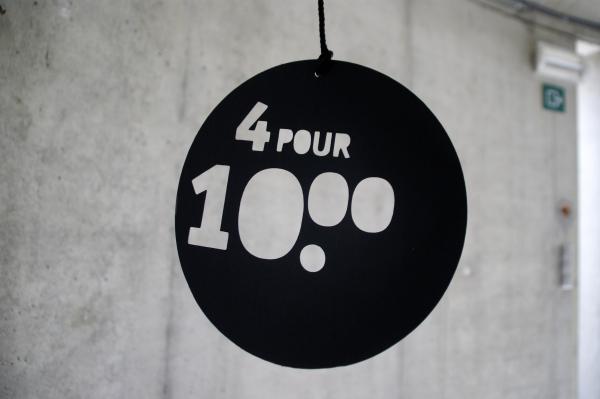
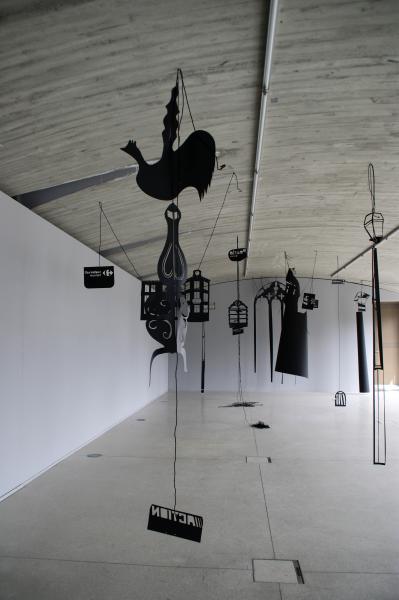
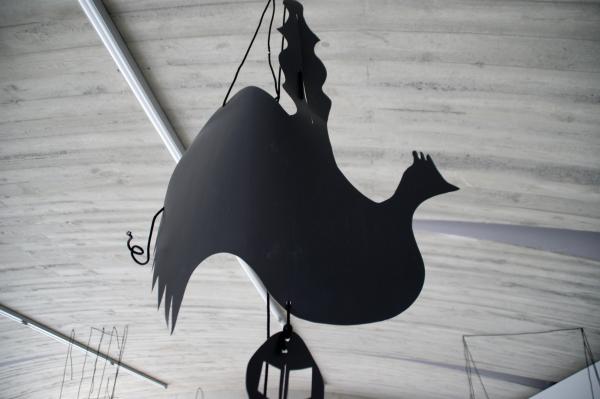
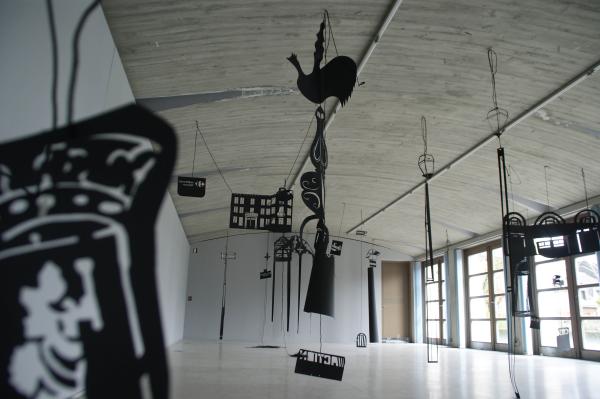
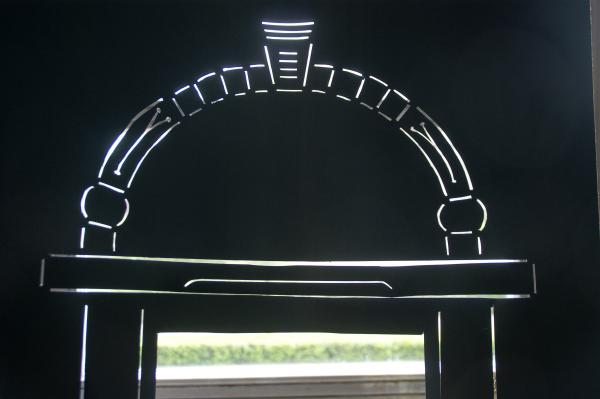
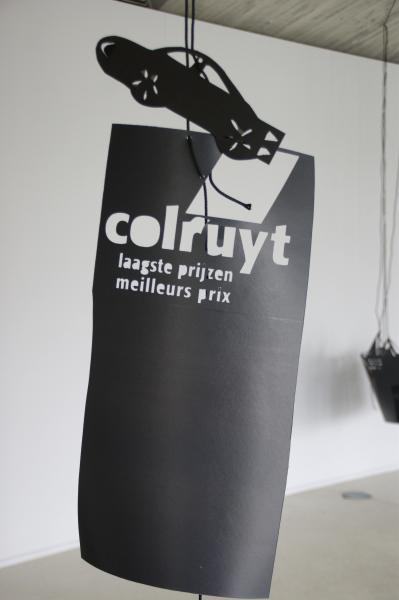
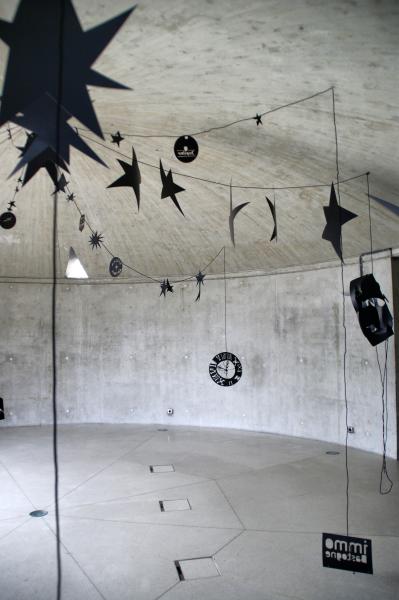

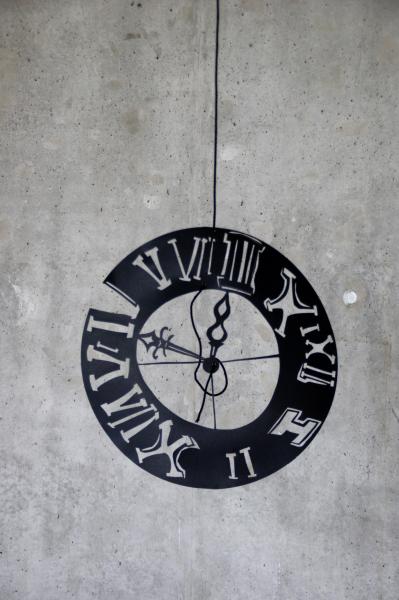
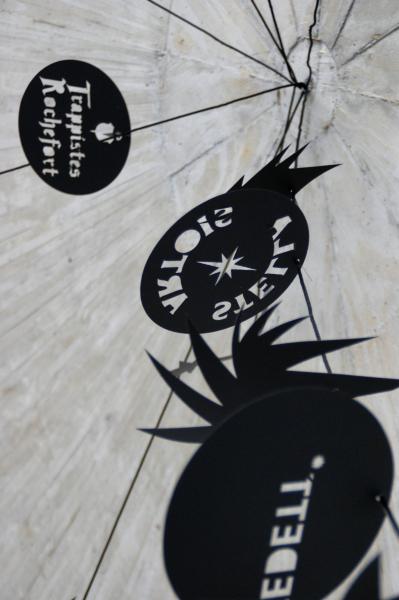
Proche des commerces (et des étoiles)
L'Orangerie, Bastogne
06.05-11.06.2023
Curator Gauthier Pierson
Project realized in collaboration with Jules Marques (11 years old), Alice Noël (11 years old), Clara dell'Erba (15 years old), Elie Verdin (12 years old ), Gustave Bastenier (13 years old )
The Orangerie art centre is keen to establish a partnership with the Bastogne youth centre. The aim is to create a project with the guests of these centres. Five children aged 11 to 15 signed up. We went for a walk around the town, equipped with simple black markers and sheets of paper. We drew Bastogne, a town in southern Belgium famous for having been the scene of the Battle of the Bulge during the Second World War. Today, it's a peaceful town with a focus on local commerce and tourism. We return to the art centre to transfer the drawings to the floor using stickers. In the evening, coats of paint are spread over the drawings. The stickers are removed in the morning to reveal the drawings. Faithful reproductions of signs in Bastogne's main street are added to the margins of the drawings. Didascalies. The fresco on the floor is augmented by a network of ropes, which traces an additional design over the paintings. The back room is blue, studded with stars.
The result is a cemetery of brands, lying on the ground, like those sad soldiers' cemeteries; a Platonic cellar, with an idea of Bastogne, in Bastogne; a childish and ingenuous version of the city built over time by adults; an alternative to the Sim's video game, a reworking of a Google Maps map; a Lascaux cave with paintings blown up in an architectural atmosphere of Walloon postmodernism; a colourful Navajo-inspired painting meditating on the West's perception of the universe.
The invitation card and poster for the exhibition interweave the names of shops and restaurants in the centre of Bastogne, an American flag, an advertisement for an estate agent and an optician. The boxes are punched with stars. These media are graphic ramblings on the Star-Spangled Banner, on the visual stimuli of a town, and on the topography that is the subject of negotiation between commerce, history and the local council.
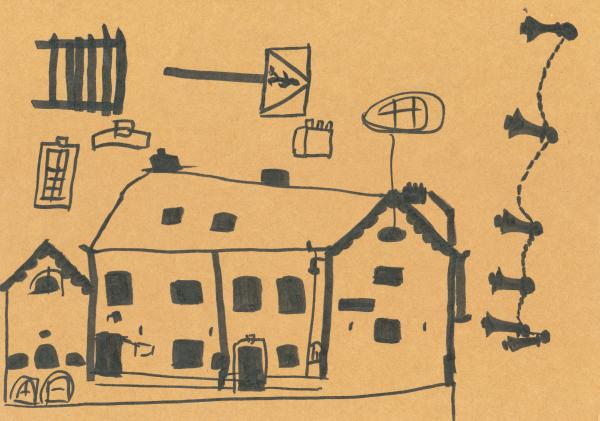
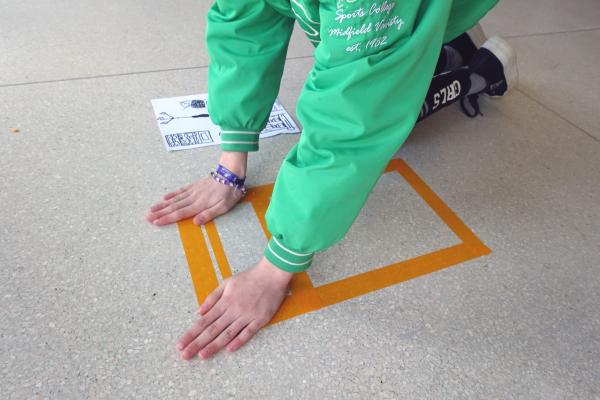
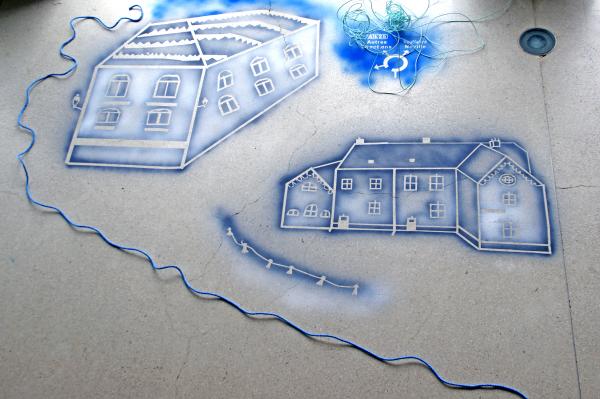
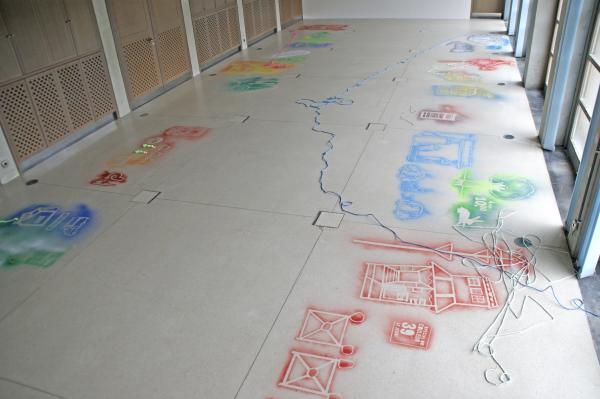
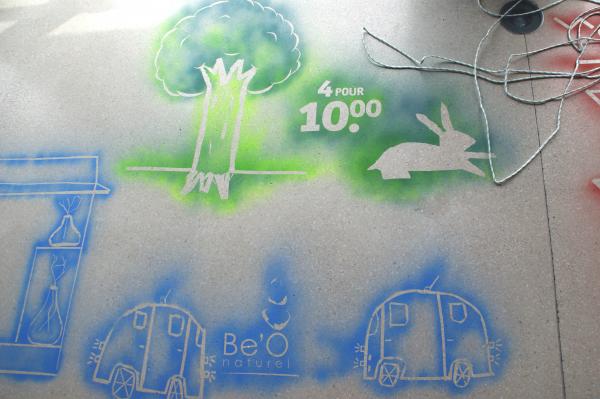
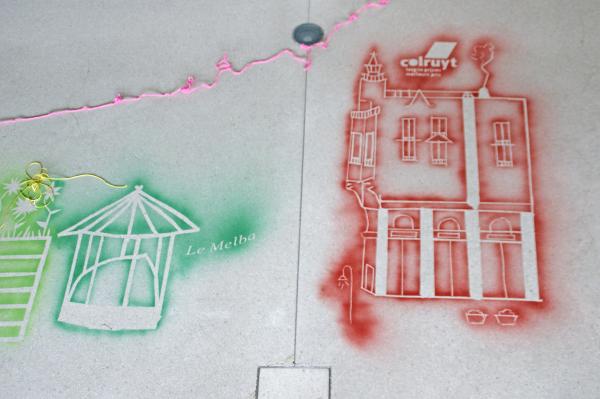
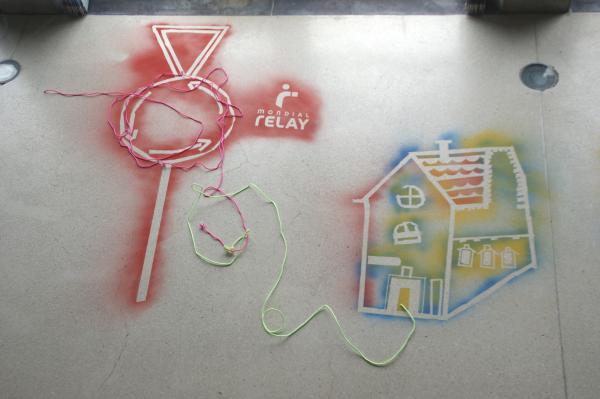
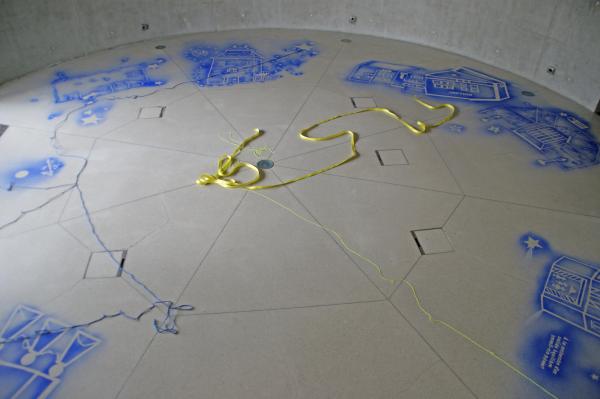
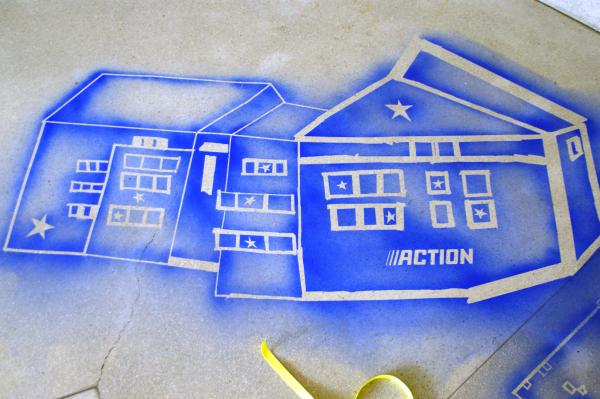
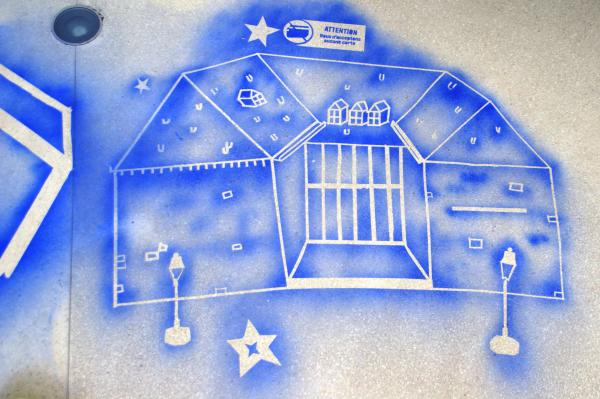
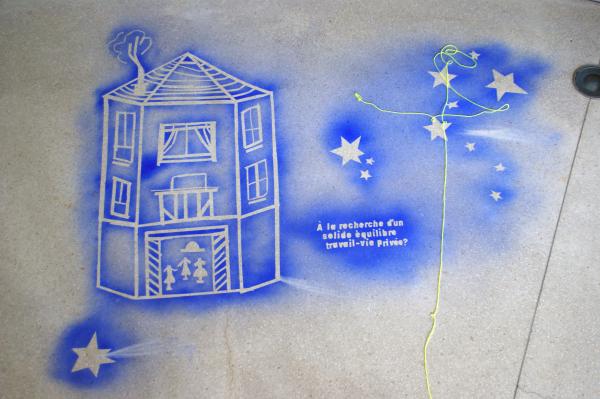
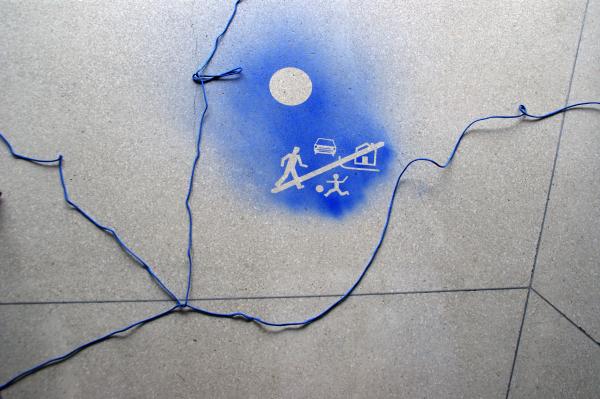
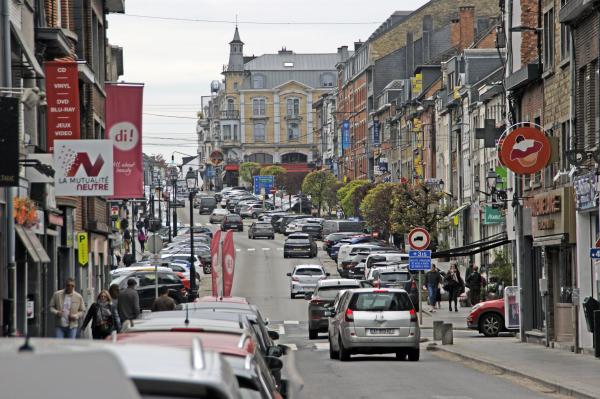
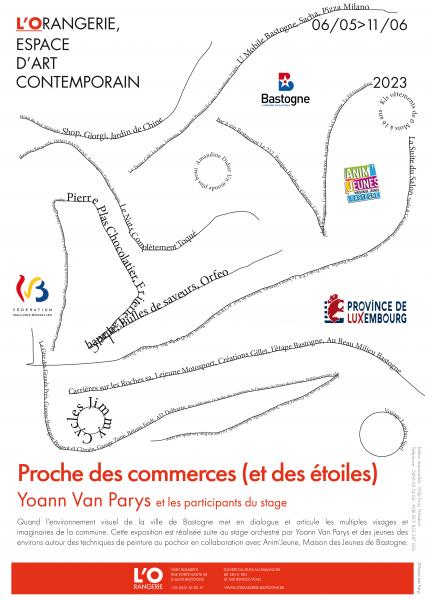
05 septembre - 01 octobre
Galerie Totem, Amiens
05.09-01.10.2022
Curators Louis Clais & Gabriel Folli
This group exhibition at the ToTem gallery in Amiens (located on the central square at the foot of the Gothic cathedral) was conceived by Louis Clais and Gabriel Folli. It has the funny title of its own start and end dates. It brings together works by Fabrice Cazenave, Louis Clais, Gabriel Folli, Marie Glaize, Raphaël Lecoquierre, Nancy Moreno and Régis Jocteur Monrozier. I first wrote a text on each of the participating artists (including myself), in the guise of a "professional man/woman": radiologist, accountant, postman, skater, optician, entrepreneur and sports commentator. These texts were then reworked to be printed on clay tablets, similar to amulets. The amulets were then hung in an alcove in the exhibition on the end of coloured strings, thus forming a puppet theatre representation of the exhibition, or perhaps the first three-dimensional press release in history. At the opening, yours truly donned his own amulet, reminiscent of ancient cuneiform writing plates, an Olympic medal, a medieval royal decoration, or even the plates worn by poor people on slave markets.
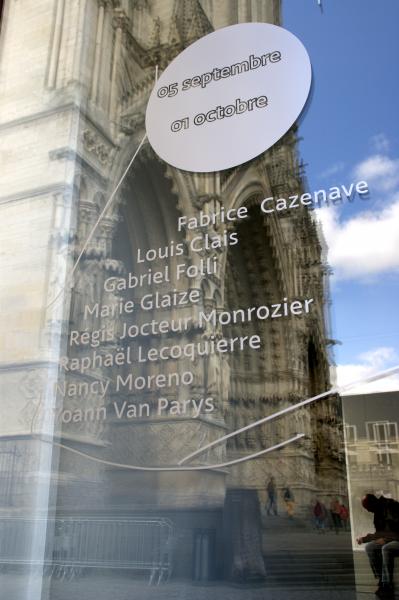
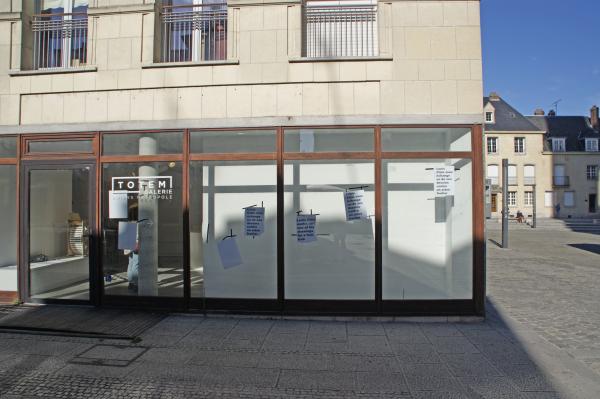
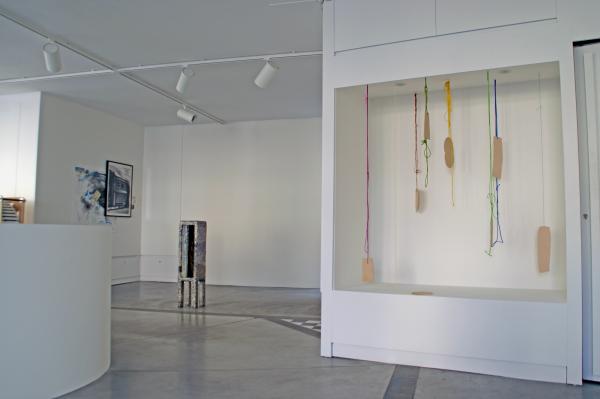
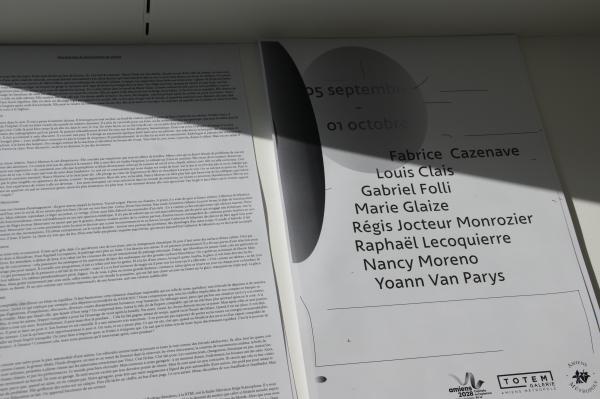
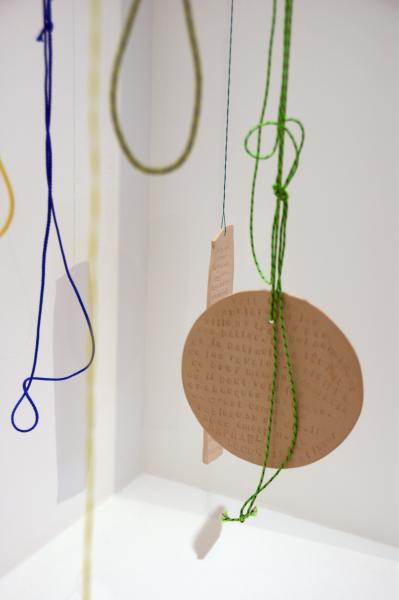
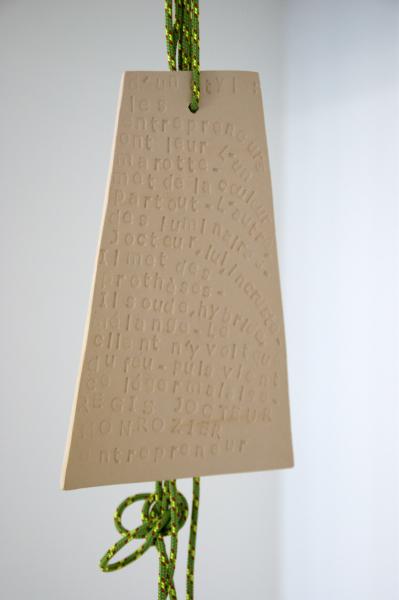
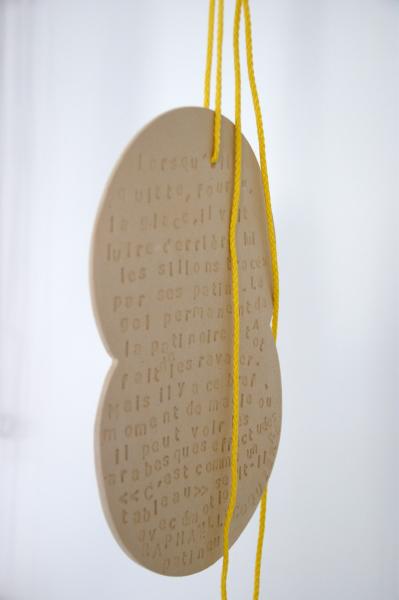
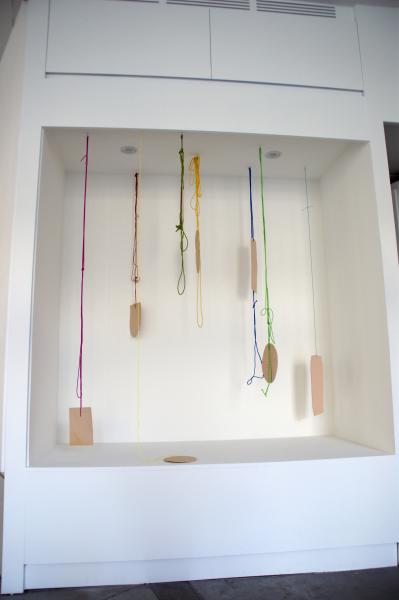
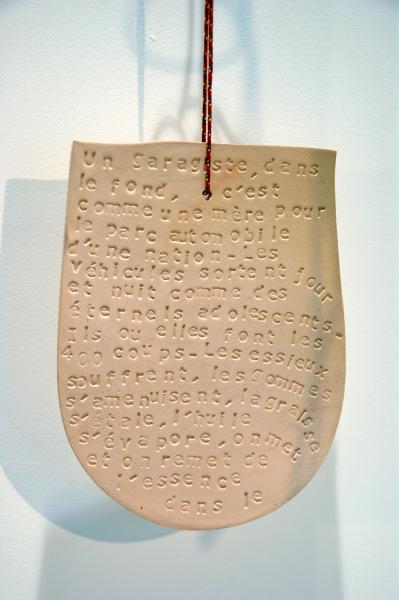
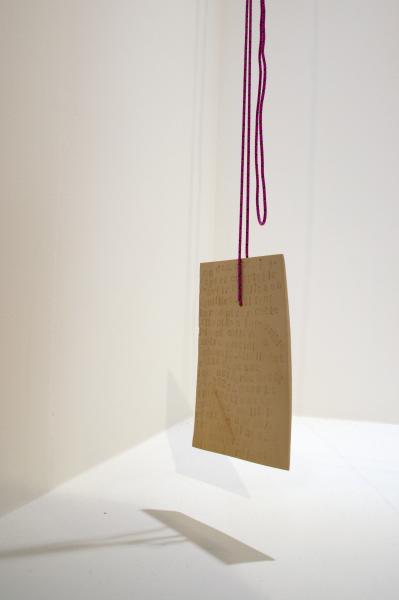
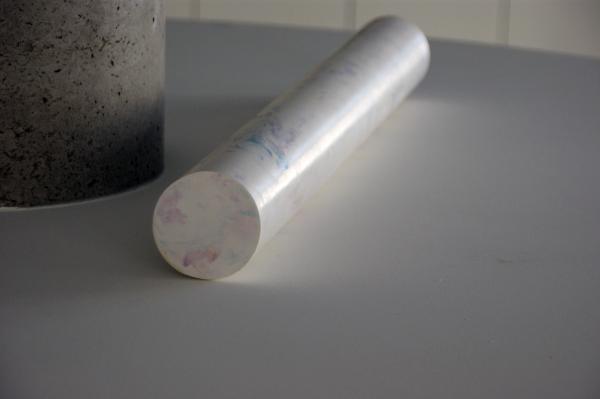
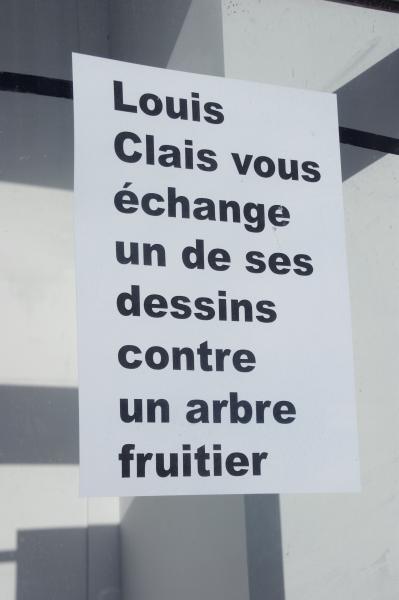
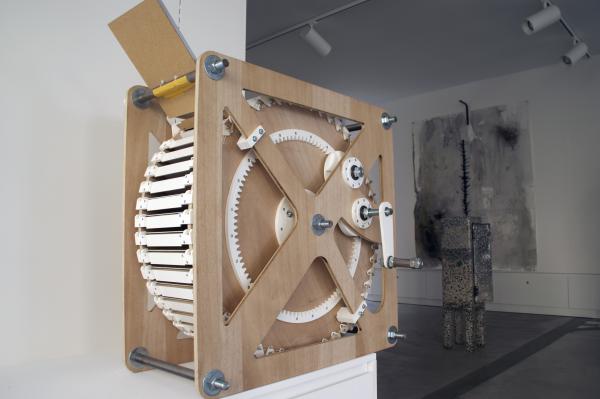
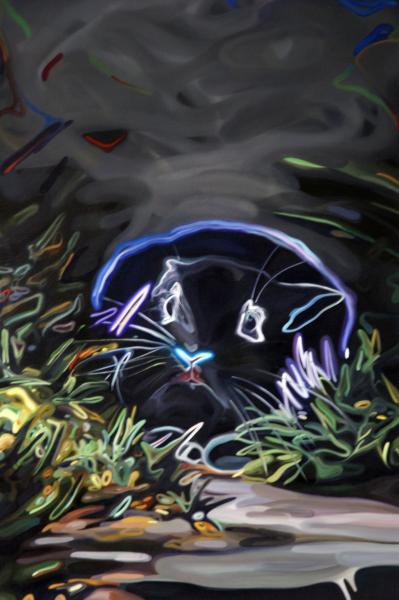
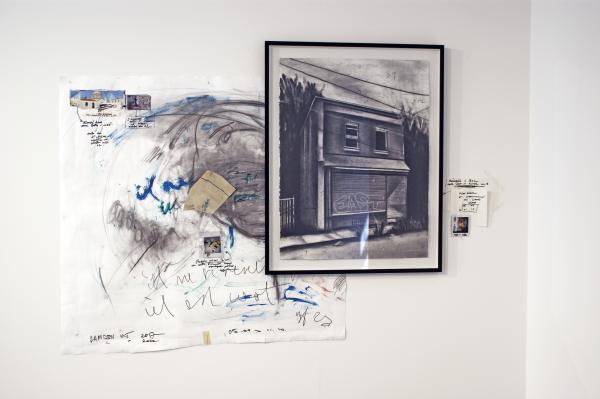
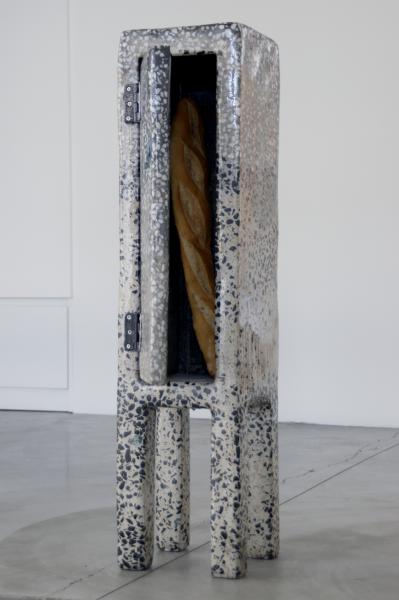
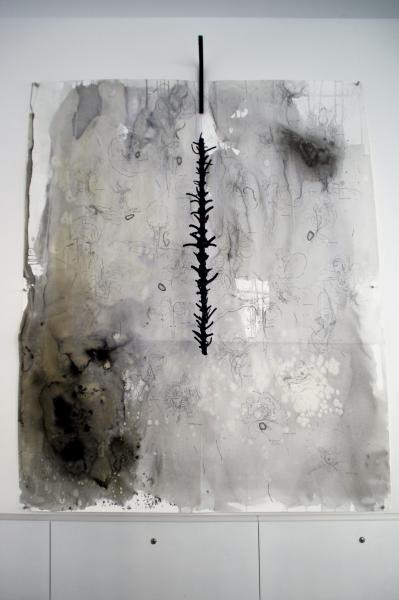
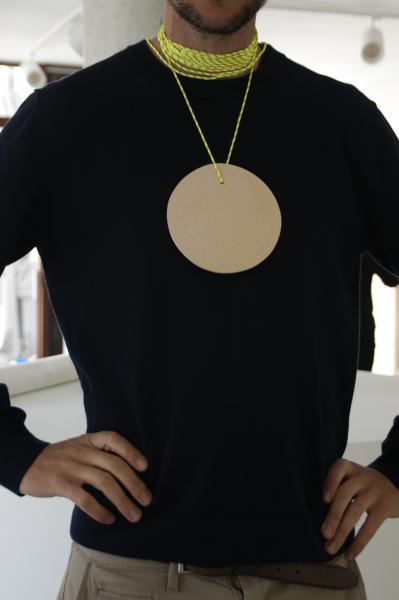
Nos éclairs de soleil dans les brumes du souci
Fructôse association, Dunkirk
04.04-16.04.2022
Curator Septembre Tiberghien
A collective residency with Ondine Bertin, Louis Clais, Valentine Gardiennet, Martha-Maria Le Bars, Pôle-Fromage, Adrien Tinchi and Yoann Van Parys
Initial text of the curator :
Act I
The Dunkirk sunset is without a doubt the most intense experience I have had in this city between 2011 and 2012. In this part of the world, which is similar to a Finistère, the sun not only ends its course in the sea, but it adorns the sky with flamboyant colors bordering on the supernatural. Some people explain this incandescent glow by the presence of fine metallic particles suspended in the atmosphere, coming from the factories of the nearby industrial port. Myth or reality? It doesn't really matter to us, since the phenomenon is a daily spectacle for the greatest pleasure of all.
Act II
March 2020 to December 2021: the health crisis of the COVID-19 deprives us, momentarily and by intermittent episodes, of our cultural rights, as defined by the Declaration of Fribourg in 2007. According to Patrice Meyer-Bisch, president of the Observatory of Diversity and Cultural Rights and member of the Fribourg Group, which created the Declaration, they can be defined as follows: "Technically speaking, they are the rights, freedoms and responsibilities for a person, alone or in community, to choose and express his or her identity by accessing, practicing and contributing to cultural references perceived as resources necessary to his or her process of identification, communication and creation."
When theaters, cinemas, concert halls, museums, art centers and other exhibition spaces are required to close to avoid the spread of the virus, in Dunkirk the sun continues to shine brightly, reminding us that an even more serious crisis, ecological this one, is shaking up the agenda of our policies. Nevertheless, in these times of pandemic, full of uncertainty and anxiety, the sunset is an inexhaustible source of joy and emotion. To look at it implies a true act of communion between man and nature, a romantic vision of which the literature and the cinema in particular were made the echo.
Act III
In the collection of the Museum of Fine Arts in Dunkirk, closed in 2015 for an indefinite period, we find many seascapes, of more or less happy workmanship, painted between the seventeenth and nineteenth century. The skies are mostly agitated by winds blowing from the sea, sometimes carrying away the ships, as in Naufrage, by Claude Joseph Vernet. Except in a few port representations, more often located in the East than in the West, as in Hendrik Van Minderhout (View of a port in the East, 1688) or Louis Gabriel Eugène Isabey (The port of Dunkirk, 1831), the sun is almost absent. How to explain the occultation of this dear star by the painters? Wouldn't drama go well with the clear horizon of fine days? The fact remains that if this phantasmatic sunset does exist, it is invisibilized in two ways: by the artists, who have chosen to show the star at its zenith rather than at its decline; and by the institution, whose collections are on external storage until further notice.
Act IV
The Belgian artist Marcel Broodthaers had imagined in his time The Museum of Modern Art, Department of Eagles, of which he was at the same time director, curator and guardian. Apart from the numerous thermoformed enamel plates bearing the museum's effigy, the only works in the collection were reproductions of paintings in postcard format. Nomadic and independent, his institution addressed the question: does the museum make the works or the other way around? Like André Malraux's imaginary museum, everyone seems to be able to carry within themselves an infinite collection of mental images that can be mobilized at will.
Epilogue
What does the experience of a sunset have to do with the exercise of cultural rights or the evocation of an invisible collection, you might ask? Whether our view of the sunset is scientific, aesthetic or political, it is no less sensitive. Putting the sensitive at the heart of our reflections on the place that culture occupies in our Western societies seems to be the solution, if not the antidote to their collapse.
This workshop proposes a questioning around these notions, through different interventions which will bring a singular lighting. Together, we will elaborate a proposal that could take several forms and be deployed according to various modalities: a travelling museum bearing the effigy of the Dunkirk sunset, an ethical charter of culture for the citizens of tomorrow, a demonstration on the Braek dike at dusk...
End of residency text by the curator :
Restituting the unrestorable
Summarizing the adventure of eight artists on the Dunkirk territory is not an easy task; it is a matter of encapsulating what is of the order of experience, of living together, of the infinitesimal border separating life from art. Or perhaps there is precisely no border, the real impregnating with persistence the materials which found the artistic practice as much as the imaginary disgorges its juices in the everyday life, abolishing thus all distinctions of forms and nature.
It is thus a process rather than a finality that one attends, although the fragments given to see seem to form the contours of an exhibition. Amongst this ensemble, the oft-questioned figure of authority - that of the artist, embodied by his signature, or that of the institution holding the knowledge and, by extension, the person of the curator who validates or invalidates the proposals - never ceases to be thwarted and reinvested.
At the heart of the preoccupations, the artist's economy, whether it is minimal or on the contrary expansive, irrigates the conversations so much that it ends up giving birth to a utopia: the world would be governed not by banks and other financial powers, but by happy people holding a symbolic currency, without fiduciary value.
This epic ends on a festive note: in the oil of the fries one can read gaiety and hard work, generosity and sin. Small gestures in the grip of a collective delirium with disinhibiting virtues arise from an involuntary neighborhood with a circus. Like the setting sun, which like the phoenix always rises from its ashes, we leave behind our doubts to taste the joy of eternal renewal.
Le Jeu de l’oie
(SIC), Brussels
18.05-05.06.2016
Exhibition organised as curator. With the support of Raphaël Pirenne, Sébastien Biset, Aurélie Bouvart, Anaël Lejeune and Olivier Mignon.
With works by Jacqueline Mesmaeker, Sylvie Eyberg, Pol Matthé, Wobbe Micha, Freek Wambacq, Christophe Terlinden, Denicolai & Provoost, Michel Goyon, Cathérine Lommée, Fiona Mackay, Pierre Gerard, Lucia Bru, Reinaart Vanhoe, Peggy Frank, Dialogist Kantor, Olivier Foulon, Joël Vermot, Leon Vranken, Cyril Bihain, Pierre Lauwers, Vaast Colson, Antoine Van Impe.
Rules of the game
Dialogist-Kantor
Proletarian artistic utopia. Don't make any art, but instigate situations that create it for you. Anyway, trust objects: they memorize more details than us. Repository of actions. Minstrels graphically performatives. Let's see if we're not somewhere over there. Journey in the country side, with comic difficulties. The elegance of the movement of the horse, in chess. But the horse is drunk, he zigzags: you must be able to imitate that.
Christophe Terlinden
Rodeo. Capturing ostrichs like with a lasso. The gesture is japanese. You must practise a lot to make it without efforts. When you get it, the real comes to you magically. Success is a job, like they say. The art of looking, in the manner of Ellsworth Kelly. Wanderings in boat, during the week, on the pond of the La Cambre's wood.
Olivier Foulon
Private archeologist. Sharp. Known in the milieu. Cambridge. Works on demand. Only on apointment. Robert Bresson : Do not show all the sides of things. Margin of vagueness. Challenging the desire (next author to consider : Roland Barthes). Meticulousness. The onion is pealed layer after layer. Disseminate his informations in a sparse way. Met Brueghel the old, but will only tell it in the end.
Lucia Bru
Plastic work. From the field of the visual, plastic, arts. Plastic surgery. Magical matter that imitates any shape. Multi purpose. Some boxes containing devices are works of art. Ghosts of spare parts through thermoforming. Grey matter = black matter + white matter. Unless there is an accident (a volcanic eruption which would cover the earth of cinders, precipitating it in a five years's night), you have the guarantee to find the light again in the morning.
Cyril Bihain
Multilingual. Germany, Belgium, Japan. Homing device guided through pipes in cast iron. A movement to the side, dexterity. Contratempo. Musician appearing briefly in a movie by Werner Herzog, dedicated to caves. Anna Oppermann. How to substantiate a volume on a flat surface? Discoveries of forgotten crafts. The spirit is visiting old logics. Web of railways, intertwined.
Pol Matthé
Russian constructivist. Italian graphic designer. Jordanian architect. Swedish poet. Indian cricket player. Afghan Backgammon player. Keeps a laboratory opened to the public, which doesn't use toxic material (or just a few), in which one consider occasionnaly the possibility to dig tunnels between identities, houses, industrial areas, gardens.
Jacqueline Mesmaeker
After a very long time, we can finally draw. To get to that point, you must conquer at leat six childhoods. Shrew. Escape game. Gymnast. Excellent in the art of crossing rivers through the ford. Hopscotch. You can always try to jump from one stone to the other like her, without breaking your ankle. English ballet, with German music.
Reinaart Van Hoe
There was one more layer under the minimalism. We restored this Vermeer. We sand it until there were almost no pigments left. Not even the wood panel. And then, a miracle: here comes a new Arte Povera. Unknown. Anemones on a sandbank. An engulfed Galleon. The crew left to clear some unknown territories of Indias. And they did it. The proof? The notebooks from the topographer we found.
Fiona Mackay
Let's propose to an extreme right-wing who would not like contemporary art, by intimate conviction, to try it, after all. The goal is still to get along. Workshop for children a little dangerous. But fundamentally humanist objective. They will realize that the slightest choice (this color rather than another, this brushstroke rather than another) relays an immense imagination. Our Nazi friends are lucky to have such a sexy mistress. British bocage, illustration books, tweed clothes. Guarantee that in this good college, they will quickly change their vocation.
Denicolai & Provoost
We used carrier pigeons during the war. Reconsider your judgment: the beach of Ostend is vast. There is plenty of room for everyone. Italians have an innate sense of community. It doesn't take much to be happy. Collective meal in a disused hospital on the Lido island. Makeshift camp, bruschetta. Midnight bath with factories, liners and the port in the distance. Or how to transform methane into gold?
Peggy Franck
Piet Mondrian went wild. We could feel that it was boiling in there, behind his little iron-rimmed glasses. Piet is one of us, he drank his glass like the others. And we can say that the result is spectacular. We can still guess his old rigor, but he adds extraordinary touches of fantasy, luminescent plastics. Now that he is launched, he can't be stopped! He even picks up girls at the bus stop.
Freek Wambacq
Egyptian huckster who handles like nobody else a kind of humor in the fifth degree for the greatest pleasure of his public who listen to him on the flat roofs of the old city until the first light of dawn without losing one of his words. He is able to make you believe in one night that the dromedary was born from a stone. A school of analogy will soon be opened and its teaching will last for five centuries.
Michel Goyon
Unknown genius of mathematics living thirty-five meters from a store selling Leonidas chocolates in Saint-Gilles. Evolved in the very closed circle of extraordinarily intelligent minds (Leonardo da Vinci, Marcel Duchamp, Raymond Roussel) who occasionally suffer mockery in the playground and other thefts of personal belongings (comics, irreplaceable objects). But thank God, this hardly affects them. And he who laughs last will laugh. Nose hair.
Sylvie Eyberg
Relational art before the letter. Letter of the relation in art. Art of the relation to the letter. Letter of the art in relation. Before the art, there is the relation. Relational letter of before. Art made of related letters. Relations of literate arts. Art of the letter to the relations. Letters to the friends that save us the life and also amuse us. Avanti ragazzi!
Joel Vermot
It seems that what characterizes the astrological sign of Virgo is the fact of being "at the service of...". It's interesting this notion of service. It's not what you think. It's not about subordination, it's about use. Besides, software is "used to...". It is not a question of manipulation either, in the Machiavellian sense of the term. No one is going to use you. If there is manipulation, we will rather talk about tinkering. Customization of old computers from the eighties. "My bike", as they say lovingly.
Pierre Lauwers
Large Glass of Marcel Duchamp. Machine to make painting. Machine of imaginations and imaginary. Works in all countries, without adapters. Last tests : Brazil. Ayrton Senna resurrected. Very close competition with León Ferrari. Beautiful fight. Does laps of the circuit in eight, at full speed. The spectator can hardly follow this mechanical ballet with his eyes. The car of Senna literally flies over the track.
Vaast Colson
Prince of the clouds who haunts the storm and laughs at the archer. Bitter sweet symphony: 215 million views on Youtube. Raven's chatter on the branch in the morning. A friend of Lee Mellon threw dynamite into the pond one night to silence the frogs. What a mess! It was Pearl Harbor in the backyard! But boy, did we have fun!
Catherine Lommée
A female version of Newton secretly exiled in our time to tackle even more complex notions than gravity. System thinking. How to translate one material into another while keeping both bodies intact? For example stone and concrete. Democracy will either be played out at the level of chemistry or it won't.
Raphaël Van Lerberghe
Essentially, an escapee. With the advantages and disadvantages of escape: the exhilarating feeling of freedom and the slight paranoia of the afternoon. What if someone... is back there? Escaped from Hennessy surrealism first. Bonnie & Clyde all by himself. He left with all the loot without asking for it. Then he escaped from the French seventeenth century. Hainaut is still close to France. There have been invasions. But with all that, nobody could track him down, except maybe Eric Rohmer and Mrs Thatcher (as Renaud sang).
Leon Vranken
South of France. Skittles and bowling. Smell of oaks and maritime pines. Overwhelming heat. Manon des sources. I believe to dream to see this perfect silhouette which is cut out with far. Mirage. Trompe-l'oeil. One would be intoxicated of this beautiful illusion. To drown the small dose of Mediterranean melancholy which knows how to seize us in the air of the evening, nothing is worth a quintuple glassful of pastis. Cut to the chord, the glassful.
Pierre Gerard
Long observation of Verlaine's verse : the long sobs of the autumn violins wound my heart with a monotonous languor. Annotations in the margin. Resumption but with unexpected jumps and turns. Fruitful trials and errors. If you work, it will lead to something said Sister Corita Kent and John Cage after her. What is the sound that the word sob makes beyond all reason and passion?
Antoine Van Impe
What immediately follows an intuition: the observation, the sign that there was indeed something there. But what is it? What is this obscure spot that I can now guess under the microscope? Magma, an ectoplasm? A disease that will decimate humanity? Or simply a piece of rubber abandoned by a mine worker in the sixties on the hillsides of the citadel in Liege? Refrain of an underground rock anthem.
Wobbe Micha
Mystery box. There is always one. Surprise case: behind the door, the void. No railing on the balcony. You are missing a support point. You tip over. Renaissance perspective triangle deduced from a vanishing point. But then? But where then? Multiple listening rooms. One in the United States, one in Asia. Galaxies. Different pull forces are at work. They rock Anakin Skywalker's ship.
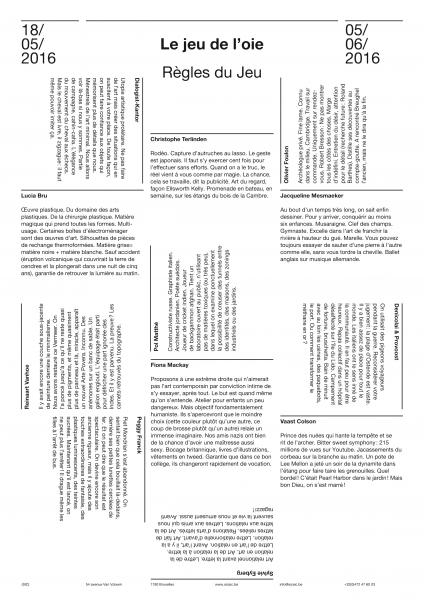
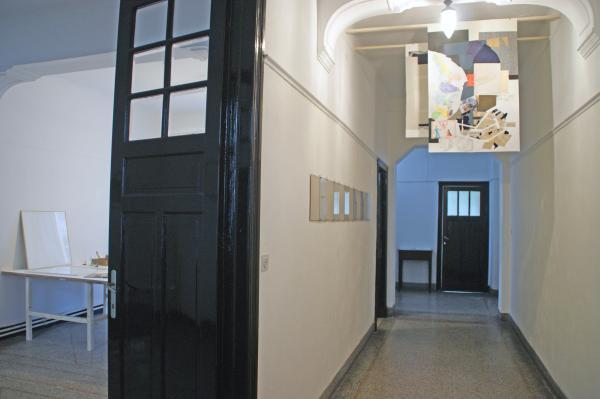
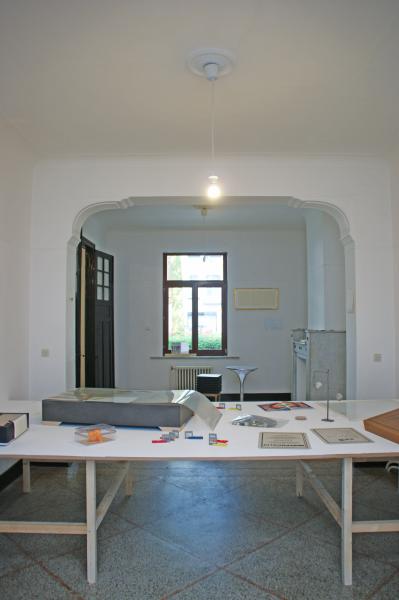
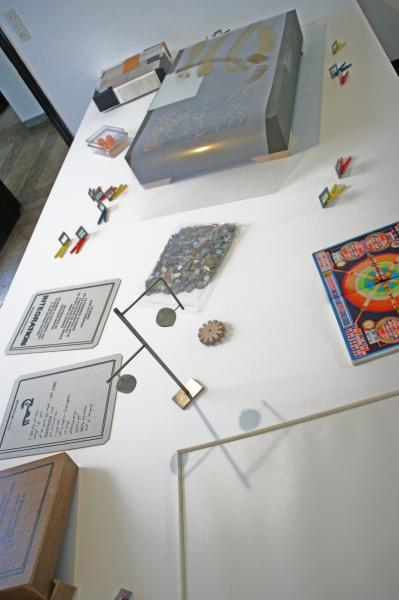
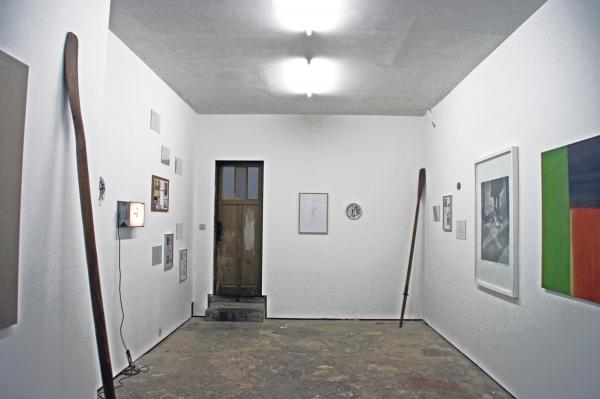
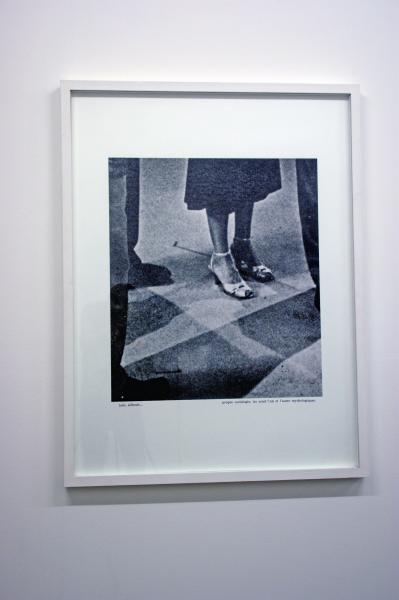
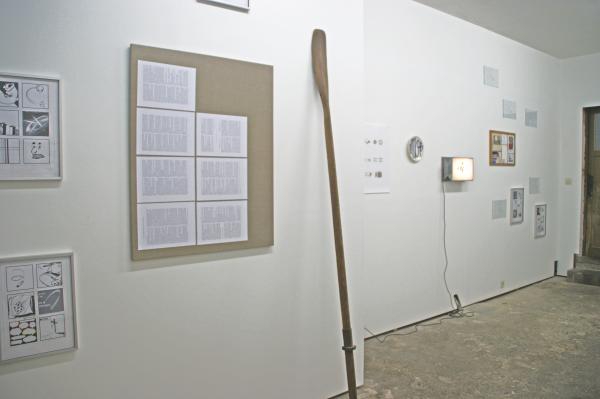
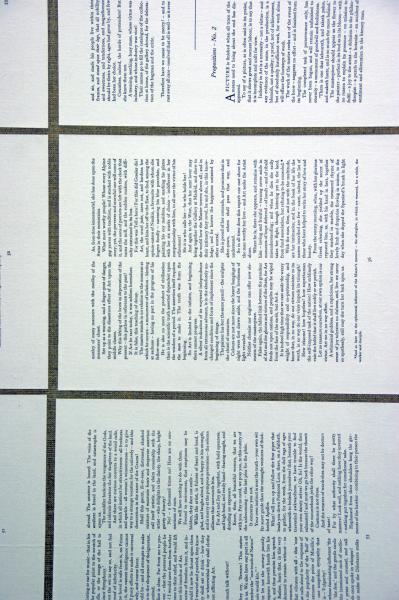
BROADCAST
Institut Supérieur pour l'Etude du Langage Plastique, Brussels
The night between March, 28 and March, 29, 2014
A project realised as a curator, in collaboration with Raphaël Pirenne, Olivier Mignon, Aurélie Bouvart, Anaël Lejeune and Sébastien Biset
With artistic contributions from Max Bourguignon, Antoine Boute, Michel Goyon, Jean-Daniel Pollet, François Winants and the Stonecutter.
Inaugural speech
Ladies and gentlemen, young girls and young boys,
The French language, which has a considerable number of expressions and formulations that have been magnificently forged over time, includes one that begins more or less with the words "If there is one thing that characterizes so-and-so, it is his inclination to... his propensity to...".
I woke up this morning thinking that it was a day of trying to put this phrase to good use.
So I began by trying to adapt it to the theme of the day.
If there is one thing that characterizes the collaboration between, say... an arts group and an arts institution, it is, in the words of a good friend, "confusion in clarity.
An institution is, after all, also an artistic group, and if there is one thing that is difficult to do, it is not only to run an artistic group, but even more to run two artistic groups.
Since there were two artistic groups here, we had, as promised, dare one say, confusion in clarity.
But then, where does this confusion in clarity take us? Because if there's one thing that's troubling, it's that confusion in clarity sometimes turns out to be "the right way".
Well... he takes us through a series of more or less evasive e-mails, based on a project that is no less evasive to begin with. And then necessarily (since there is "communication"), he takes us into the writing of a text announcing it. And this is where things happen in two stages.
First we have our own text, which is a quote from the well-known art historian Leonard Bordes, dating from 1929:
"One should not try to explain why the work is beautiful. Men hardly agree on the nature of beauty. These two words themselves swear to be coupled, and make understand how much such an ambition would be ridiculous. It would even be harmful for the goal that one pursues. On this question, the din of brains of which Montaigne speaks is particularly noisy. But if the why escapes us, the analysis allows us to see the details where this beauty resides and to determine certain characters of it ".
And then we have in complement (counterpoint? clarification?) of this quotation, the text of the Iselp (thus of the second artistic group) which says as for him this:
"For ten years, the editorial and curatorial platform (SIC) has occupied an essential place on the Belgian artistic scene. The group has notably illustrated itself by the editorial residency set up for the Off of the last Biennale of Visual Arts in Venice. Invited to L'iselp to explain their collective practice, they proposed to understand how it works through a scouting initiation.
If there is something that characterizes this text at first sight, it is that it is flattering. So I say thank you.
But if there is something that characterizes this text at second glance, it is precisely that it puts us on the track of the "right path" by showing confusion in clarity, or rather, this time precisely, clarity in confusion.
Indeed, the words suddenly become very precise. "Invited to the iselp to explain their collective practice"... collective practice... invited to the iselp..." They proposed to understand how it works through a scouting initiation"...
"To propose to understand...".
The formula is very beautiful. So there, thank you Iselp a second time...
Now - and we come to the point - if it is a question of "proposing to understand", then a first observation is necessary:
If there is one thing that characterizes the functioning of an artistic group (let's call it that, although it could be a group of lumberjacks, a think tank, any group of assholes), it is the fact that there exists within it a certain form of tension, due to an underlying rivalry of -individuals- put in a crisis situation and so on.
It is thus the reign of no, rather than yes, of rivalry rather than solidarity. There is inevitably something of a "fratricidal struggle", to a greater or lesser degree.
You'll tell me it's sad to see it that way. I know, but that's the way Ad Reinhardt would say it. He defended the fact that the only affirmation in art was negation.
So he said: the ten rules for a new art practice are: no texture/no brushwork/no drawing/no shape/no design/no color/no light/no space/no time/no size, no scale/no movement/no object... After all that, according to Ad Reinhardt, we can ( we could) start.
You will say to me, it is very sad to see things under this angle. I know, but that's the way Ad Reinhardt would say it. He defended the fact that the only affirmation in art was negation.
Thus, he said: the ten rules for a new art practice are: no texture/no brushwork/no drawing/no shape/no design/no color/no light/no space/no time/no size, no scale/no movement/no object... After all that, according to Ad Reinhardt, we can ( we could) start.
Thus, to take up this assertion turned to the negative: there is no artistic group without fratricidal struggle.
If there is one thing that characterizes the artistic group, it is that it is crossed with more or less high dose of intestine tension.
Since we arrived fortuitously at this deduction by the detour of the confusion in the clarity, resulting from the meeting of two artistic groups: the iselp and sic, it seemed to us that it was necessary to be consistent with this idea.
Because somewhere: all this has nothing childish. I speak to you here of honor! of symbolic fight, of fight all the more important that it is a symbolic fight...
This is why, dear friends, tonight we are going to confront each other, between brothers (and sisters) on a series of tests.
We will begin by constituting the two groups, and in order to set the scene from the outset (which has nothing to do with a scene because it is something concrete and not illusory), we will proceed with a cruel selection, as nature practices.
We will determine two team leaders, who will choose in turn among the registered participants, the members of their respective team, by elimination, as in the past during the gymnastics classes, which constitute a good introduction to the "curatorial practice" to take up the words of the ISELP.
Then we will confront each other throughout the evening, both to play this symbolic struggle, but also to test it, to put it to the test in moments where the border between good and evil, friend and foe, is likely in the end and thanks to the thousand helpings of our personalities and circumstances, to blur.
